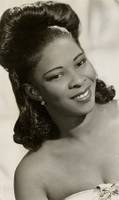"Chasing Rainbows" (T. Royal)
Johnny Adams, from After All The Good Is Gone, Ariola, 1978
Good and gone
Alright, I promised you some Johnny Adams a while back when mentioning him as one of the greatest New Orleans vocalists. Really in a league of his own, he could sing anything and make it worth hearing; but, when he gave good material his all, his voice was a profoundly moving instrument. And, I know it’s a cliché; but this man was a class act, who could turn a gig at some dive into a command performance. I saw him do it. Please read
Jeff Hannusch’s excellent, informative career retrospective for
Offbeat. After a 40 year career, Adams died in 1998, performing and recording with grace and style up to the end.
“Chasing Rainbows” was the flip side of Johnny Adams’ 1978 Ariola single, “After All The Good Is Gone”, and appeared on the same-named album, which is where I got the track you hear. The song, an odd paring to a Conway Twitty cover, was written by then New Orleans-based guitarist and songwriter Teddy Royal, who you may recall co-wrote our Willie Harper feature, “Look At The Clock” and worked with King Floyd. Arranged by Wardell Quezergue, who should be familiar to you regular readers by now, “Chasing Rainbows” is truly a funked-up piece of work throughout. On top of that undulating instrumental bed, Adams does his sweet soul shouting, which still only hints a his amazing vocal range.
We are blessed to have so much of his recorded output currently available on CD, as a brief visit to Amazon will show you. I encourage you to explore it. To get some additional tastes of his singing, try the
Soul Club Jukebox or another site I found, which seems to have his Rounder “best of” CD tracks available to
hear. It was Rounder, though their series of superbly produced Johnny Adams CDs from the ‘80’s through the ‘90’s, that finally brought him to the attention of so many modern blues, soul and jazz fans. Scott Billington and the label deserve their props for that. So, buy something from ‘em already.
My one chance to meet Johnny Adams came after a sparsely attended gig at the Rock ‘n Bowl in New Orleans a year or so before he died. We took some friends who had never heard him; and they were duly impressed. After staying to the end, we walked downstairs to find Johnny himself standing at the curb waiting for his ride. Introductions were made. I told him that I played his stuff on my radio show in Memphis. We all profusely thanked him for a great night of music. Very graciously, he thanked us for coming, and, as his car pulled up, he invited us to a gig the next weekend that he was doing in Baton Rouge, I think, where he was living. As I recall, he said it was at a high school. I thought, “What is a giant like Johnny Adams doing playing at some high school (or a bowling alley)?” A gig, my friends, is a gig. We couldn’t make it. And I never got to hear him live again; but I’ll always remember that night and every other time I saw him perform. Like I said, it didn’t matter where he was, his vocal gifts transformed the room and elevated all of us.















